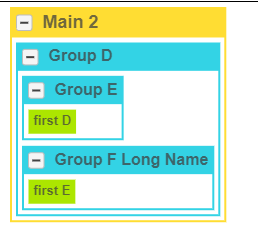I have a diagram with groups that contain multiple child groups. I’m trying to get all the child groups to stretch horizontally to fill the parent group.
I can reproduce my issue using this example: Regrouping Demo
And this model data:
{ “class”: “go.GraphLinksModel”,
“nodeDataArray”: [
{“key”:2, “text”:“Main 2”, “isGroup”:true, “category”:“OfGroups”},
{“key”:6, “text”:“Group D”, “isGroup”:true, “category”:“OfNodes”, “group”:2},
{“key”:7, “text”:“Group E”, “isGroup”:true, “category”:“OfNodes”, “group”:6},
{“key”:8, “text”:“Group F Long Name”, “isGroup”:true, “category”:“OfNodes”, “group”:6},
{“text”:“first D”, “group”:7, “key”:-14},
{“text”:“first E”, “group”:8, “key”:-15}
],
“linkDataArray”: [ ]}
Note that “Group E” doesn’t stretch to fill the horizontal space even though stretch: go.GraphObject.Horizontal is specified in the template.

Is there a simple way to do this? I saw another post mentioning using the Swim Lane example to write a custom layout manager, is that the best approach here?
